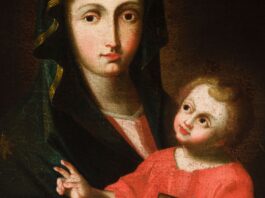
The Basilica of Saint Mary Major, the most significant church in Rome dedicated to Our Lady, dates back to the year 352 during Pope Liberius’ reign. An intriguing legend tells of an aristocratic couple, John and his wife, who had no children. They prayed fervently to the Blessed Mother, asking her to designate an heir to inherit their fortune.
On the night of August 4-5, the couple were blessed with a dream in which Our Lady of the Snows appeared to them. She requested that they build a church in her honor on the Esquiline hill. The miraculous sign accompanying this dream was the outline of the church marked in snow on a hot summer night.
Not only did the couple dream of this miraculous event, but so did Pope Liberius. As dawn broke, both the couple and Pope Liberius rushed to the site and were met by a crowd of people marveling at the unusual snowfall. The area outlined by the snow was marked off before it could melt, and construction of the church began.
Within two years, the basilica was completed and consecrated by Pope Liberius, earning it an alternate name – the Basilica Liberiana. After the Council of Ephesus in 431 A.D. affirmed Mary as Theotokos, or the God-bearer, Pope Sixtus III rebuilt and embellished the basilica. From the 7th century onward, it was often referred to as St. Mary the Great or Major. It was also occasionally called Our Lady of the Snows, recalling the miraculous snowfall that prompted its construction.
One of the basilica’s most precious treasures is the painting of Madonna and Child, named Salus Populi Romani, believed to be painted by St. Luke. It was retrieved from the Holy Land by St. Helena, mother of Emperor Constantine. This revered painting was initially housed in Pope Liberius’ private chapel but was later moved to the Basilica for public veneration.
Over the centuries, this famous image of Our Lady has been held in great esteem. Popes have carried it in processions, praying to the Protectress of the People of Rome during times of plague and cholera. In recognition of these answered prayers, Pope Gregory XVI placed crowns of gold and gems on the heads of Mary and the child Jesus in the image.
In the 17th century, Pope Paul V commissioned a special chapel to house this venerated image. In the heart of the basilica, under the high altar, the manger from Bethlehem’s stable is venerated.
The Basilica of St. Mary Major’s Dedication feast is celebrated annually on August 5th. A delightful tradition on this day is the showering of white rose petals from the dome of the Chapel of Our Lady, symbolizing the miraculous snowfall that inspired the church’s construction.
Photo credit: Public Domain via Look and Learn
The post Our Lady of the Snows appeared first on uCatholic.
Daily Reading
Wednesday of the First Week in Ordinary Time
Reading I Hebrews 2:14-18 Since the children share in blood and Flesh, Jesus likewise shared in them, that through death he might destroy the one who has the power of…
Daily Meditation
Ripples in a Pond
Click here for daily readings There is something captivating about tossing stones into a pond or lake. Maybe it is the disappearance of the stone as it plops into the…




